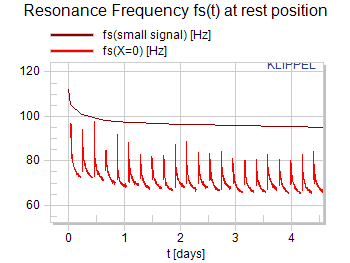Power Testing (PWT) - Deprecated
A new dedicated solution for long-term, power and accelerated life tests is available. For more information, please visit our product site KLIPPEL Endurance Testing (KET).
The PWT software is still available for customers having a Power Monitor PM8 for eight-channel test and a Distortion Analyzer DA2 hardware unit for single or dual-channel tests. Please contact support(at)klippel(dot)de for details.
Features and Benefits
- Long term driver testing without sensor
- High-speed temperature monitoring
- Ideal for thermal parameter measurement
- Full mechanical identification of transducers (woofer, micro-speaker)
- Mechanical and thermal load versus time
- Permanent identification of voice coil offset and fs (no persistent excitation by stimulus required)
- Monitors destruction process
- User defined failure limits
- Measures up to 8 DUTs simultaneously
- Stand-alone operation
- Driver status displayed on hardware
- Analysis of recorded measurement
- Internal signal generator
- Stimulus shaping/filtering
- Variable slope (6,12, and 24 dB in high-pass and low pass filter)
- Any external signal (music)
- Control of amplitude at terminals
- Stepping amplitude
- Cycle scheme (ON/OFF)
The Power Test Module (PWT) and the hardware platform Power Monitor 8 (8 channels) allow performing destructive tests of transducers with permanent monitoring of electrical, mechanical and thermal state variables and parameter variations. An externally or internally generated excitation stimulus may be controlled in amplitude, spectral bandwidth or crest factor and may be supplied to the transducer permanently. The increase of the voice coil temperature can be measured by monitoring the electrical impedance of the speaker using a conventional AC-coupled amplifier (The mechanical parameters and the instantaneous displacement of a transducer can be monitored by impedance measurements dispensing with acoustical, mechanical or thermal sensors). The speaker parameters and state variables are sampled periodically and stored in a buffer in the hardware unit. Connecting a computer via USB to the hardware platform allows for viewing and investigating the destruction process in detail. This information is crucial for finding the physical cause of the failure and for understanding the temporal order of the destructive events. This enables the user to assess the maximal limits of the transducer more precisely.
Specification
Products
PWT Lite
Was designed for traditional power testing, monitoring voltage, current, resistance and temperature.
PWT Pro
Also provides the "Transducer Identification" mode, which monitors the large signal parameters during the power test and helps find the cause of defects (woofer, micro-speaker, vented box).
PWT Intermittent Summary Tool
Provides a comprehensive summary of power test measurements, interrupted by cooling pauses and small signal measurements.
Standard Measurements performed by PWT
Requirements
Hardware
- Power Monitor 8 - deprecated
- Distortion Analyzer - deprecated
Software
- dB-Lab release 212 and below
Accessories
The PWT Intermittent Summery Tool provides a comprehensive summary of intermittent testing. Long-term monitoring tests are used to observe the loudspeaker parameter variation over a long measurement time (from hours to month) while using a natural audio stimulus (e.g. music) or an artificial test signal (e.g. noise). For monitoring of large signal parameters, this is done by on-line testing in the large signal domain using the normal power test stimulus. Monitoring of the small signal parameters requires intermittent testing by interrupting the power test and performing separate small signal measurements. A pause is included in the measurement to assure any transient effects from the large signal measurements have decayed (e.g. temperature).
Templates
Operation and/or object templates for this module are available when creating a new operation or object in dB-Lab. This provides application specific setups and standard conforms tests.
Please find details on templates in Application Note AN 1001.
Related Information
Standards
Consumer Electronics Association
CEA-CEB19, CEA-2006-A, CEA-2019
International Electrotechnical Commission
IEC 60268-5, IEC 60268-7, IEC 60268-21, IEC 60268-22, IEC 62458, IEC WD 63034
European Standards
BS EN 54-24
Patents
Germany: 10 2007 005 070; USA: US8,078,433B2; China: ZL200810092055.4; Japan: 5364271; India: 162/DEL/2008; Germany: 10 2012 020 271 7; USA: 10,110,995; China: 201380054458.9;Korea:10-2015-7012390;Taiwan: 102137485;India: 844/MUMNP/2015



